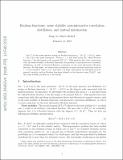Boolean Functions: Noise Stability, Non-Interactive Correlation, and Mutual Information
Author(s)
Li, Jiange; Medard, Muriel
DownloadAccepted version (230.3Kb)
Open Access Policy
Open Access Policy
Creative Commons Attribution-Noncommercial-Share Alike
Terms of use
Metadata
Show full item recordAbstract
© 2018 IEEE. Let T- ϵ be the noise operator acting on Boolean functions f: 0,1 nrightarrow 0,1, where ϵin[0,1/2] is the noise parameter. Given p > 1 and the mean mathbb Ef, which Boolean function f maximizes the p-th moment mathbb E(T- ϵf) p- ? Our findings are: in the low noise scenario, i.e., ϵ is small, the maximum is achieved by the lexicographical function; in the high noise scenario, i.e., ϵ is close to 1/2, the maximum is achieved by Boolean functions with the maximal degree-1 Fourier weight; and when p is an integer, the maximum is achieved by some monotone function, and in particular, among balanced Boolean functions, the maximum is achieved by any function which is 0 on all strings with fewer than n/2 1 ,s when p is large enough. Our results recover Mossel and O'Donnell's results about the problem of non-interactive correlation distillation, and confirm a conjecture of Courtade and Kumar on the most informative Boolean function in the low noise and high noise regimes. We also observe that Courtade and Kumar's conjecture is equivalent to that the dictator function maximizes mathbb E(T- ϵf) p for p close to 1.
Date issued
2018-06Department
Massachusetts Institute of Technology. Research Laboratory of ElectronicsPublisher
IEEE
Citation
Li, Jiange and Medard, Muriel. 2018. "Boolean Functions: Noise Stability, Non-Interactive Correlation, and Mutual Information."
Version: Author's final manuscript